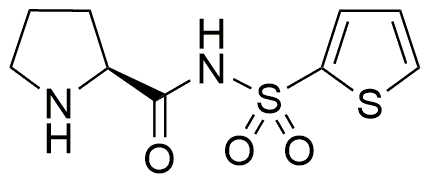N-(2-Thiophenesulfonyl)-L-prolinamide is widely utilized in research focused on:
- Pharmaceutical Development: This compound is explored for its potential as a drug candidate due to its unique structure, which may enhance the efficacy of treatments targeting specific diseases.
- Biochemical Research: It serves as a valuable tool in studying enzyme inhibition and protein interactions, helping researchers understand complex biological processes.
- Material Science: The compound is investigated for its properties in creating novel materials, particularly in organic electronics and photonic devices, where its unique characteristics can improve performance.
- Agricultural Applications: Research is ongoing into its use as a pesticide or herbicide, leveraging its chemical properties to develop safer and more effective agricultural solutions.
- Analytical Chemistry: It is used in various analytical techniques, aiding in the detection and quantification of other compounds, which is crucial for quality control in pharmaceuticals and food industries.
General Information
Properties
Safety and Regulations
Applications
N-(2-Thiophenesulfonyl)-L-prolinamide is widely utilized in research focused on:
- Pharmaceutical Development: This compound is explored for its potential as a drug candidate due to its unique structure, which may enhance the efficacy of treatments targeting specific diseases.
- Biochemical Research: It serves as a valuable tool in studying enzyme inhibition and protein interactions, helping researchers understand complex biological processes.
- Material Science: The compound is investigated for its properties in creating novel materials, particularly in organic electronics and photonic devices, where its unique characteristics can improve performance.
- Agricultural Applications: Research is ongoing into its use as a pesticide or herbicide, leveraging its chemical properties to develop safer and more effective agricultural solutions.
- Analytical Chemistry: It is used in various analytical techniques, aiding in the detection and quantification of other compounds, which is crucial for quality control in pharmaceuticals and food industries.
Documents
Safety Data Sheets (SDS)
The SDS provides comprehensive safety information on handling, storage, and disposal of the product.
Product Specification (PS)
The PS provides a comprehensive breakdown of the product’s properties, including chemical composition, physical state, purity, and storage requirements. It also details acceptable quality ranges and the product's intended applications.
Certificates of Analysis (COA)
Search for Certificates of Analysis (COA) by entering the products Lot Number. Lot and Batch Numbers can be found on a product’s label following the words ‘Lot’ or ‘Batch’.
Numéro de catalogue
Numéro de lot/série
Certificates Of Origin (COO)
This COO confirms the country where the product was manufactured, and also details the materials and components used in it and whether it is derived from natural, synthetic, or other specific sources. This certificate may be required for customs, trade, and regulatory compliance.
Numéro de catalogue
Numéro de lot/série
Safety Data Sheets (SDS)
The SDS provides comprehensive safety information on handling, storage, and disposal of the product.
DownloadProduct Specification (PS)
The PS provides a comprehensive breakdown of the product’s properties, including chemical composition, physical state, purity, and storage requirements. It also details acceptable quality ranges and the product's intended applications.
DownloadCertificates of Analysis (COA)
Search for Certificates of Analysis (COA) by entering the products Lot Number. Lot and Batch Numbers can be found on a product’s label following the words ‘Lot’ or ‘Batch’.
Numéro de catalogue
Numéro de lot/série
Certificates Of Origin (COO)
This COO confirms the country where the product was manufactured, and also details the materials and components used in it and whether it is derived from natural, synthetic, or other specific sources. This certificate may be required for customs, trade, and regulatory compliance.

